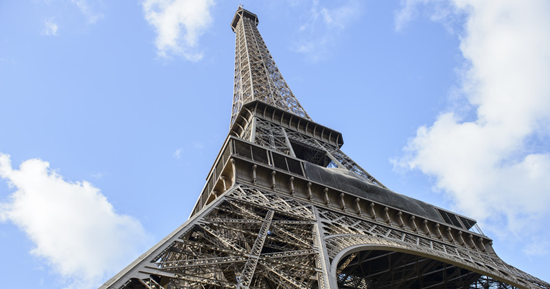
17 sensational observation towers that aren't in Paris
By Matt Hickman, Mother Nature Network, 5 August 2016.
By Matt Hickman, Mother Nature Network, 5 August 2016.
The Eiffel Tower - a 986-foot object of disdain erected as a temporary attraction for 1889's Exposition Universalle that has stuck around for 125-plus years as a tourist attraction - is an observation tower that needs no explanation.
However, there are plenty of other landmark observation towers that do, many affixed with massive antennae and pulling double-duty as telecommunications hubs.
To celebrate towering feats of imagination and structural engineering that aren't located in Paris, we've rounded up 17 of the world's most unique and impossibly high towers with open-to-the-public observation decks. Most of our mega-lanky picks offer a range of different high-altitude activities from abseiling (no, thanks) to fine dining (yes, please) but all have one thing in common: they each offer unparalleled panoramic views.
1. British Airways i360
The brand new 531-foot-tall British Airways i360 in the seaside town of Brighton, England, is the world's tallest moving observation tower. And with a diameter of just over 12 feet, it also set a Guinness world record for being the slimmest.
The tower has a viewing pod made of glass and steel that takes about 200 visitors at a time up 400 feet up in the air, where they can see sweeping 360-degree views across Brighton, the South Downs and the English Channel. It's reportedly a 20 to 30 minute trip up, and guests can dine, drink and shop during the ride.
The British Airways i360 was conceived and designed by Marks Barfield Architects - the same team that created another famous landmark in England: the London Eye.
Not everyone is thrilled with the world's first vertical cable car. Some residents have dubbed it the "i-sore," the BBC reports, along with other less-printable names derived from its shape: a long shaft with a bulge at the top.
2. ArcelorMittal Orbit
How to describe the most difficult-to-pronounce observation tower to hit the United Kingdom? We're not entirely sure!
Designed by renowned artist Anish Kapoor and designer Cecil Balmond of global engineering firm Arup, the ArcelorMittal Orbit is both a functional observation tower and a sculpture. In fact, at 376 feet, it's Britain's tallest sculpture and largest work of public art. Erected to be an everlasting fixture of London's Olympic Park, ArcelorMittal Orbit, like many great works of public art, is polarizing. The tower boasts both fervent admirers and detractors, with the latter camp referring to it as "an enormous wire-mesh fence that has got hopelessly snagged round the bell of a giant French horn" (The Sunday Times) and "a catastrophic collision between two cranes" (The Daily Mail).
Constructed from 2,000 metric tons of largely recycled steel (ArcelorMittal is the world's largest steel company), the swooping, swirling structure certainly can't be called boring as there's a lot to do at the tower aside from gawk at it from a distance: abseiling, noshing, after-hour partying, hoofing it down a 455-step staircase and, of course, taking in truly spectacular panoramic views of Olympic Park and the city beyond from the main observation deck.
3. Blackpool Tower
Soaring 518 feet over the fading seaside resort of Blackpool - a.k.a. the Coney Island or, more aptly, the Asbury Park, of North West England - this Victorian-era Lancastrian landmark built from iron and steel may be disregarded as Eiffel Tower-lite by some observation tower purists considering that, unlike its twice-as-tall Parisian inspiration erected just five years prior in 1889, it's not a freestanding structure.
Pshaw! Blackpool Tower is still a bona fide British tourist magnet up there with Big Ben, the Tower Bridge and, um, Devon's garden gnome sanctuary. Topped with a lift-accessible "Eye" complete with glass-bottomed observation deck, the tower emerges from a hulking, promenade-facing brick base structure - and what a gloriously action-packed base structure it is. You see, the complex beneath the Blackpool Tower is arguably as famous as the view-heavy tower itself. It's home to both the historic Tower Ballroom and the Tower Circus, a long-running extravaganza that's been animal-free since 1990. And while Dr. Cocker's Aquarium, Aviary and Menagerie is long gone from its original site, in its place tracksuit-clad visitors will find Blackpool Tower Dungeon, an attraction billed as "the ultimate thrill-filled journey through 1,000 years of Lancashire's murky past." We'll stick to the tower, thanks.
4. Canton Tower
While China's new breed of razzle-dazzle observation wheels have gotten most of the attention, a few observation towers of considerable height have also gone up over the past decade or so. Surmounting them all is Canton Tower, a Dutch-designed multipurpose tower that sports some serious curves as it twists its way high above the Pearl River metropolis of Guangzhou. Lit up at night by LEDs projecting a joyful, Rainbow Brite-approved glow, Canton Tower was, for a brief spell, the tallest tower in the world from 2009 to 2010, which is when the Tokyo Skytree arrived on the scene.
At 1,969 feet tall, the hyperboloid behemoth is now the third tallest tower in the world and the tallest in China. Not-quite-as-high contemporaries include Zhongyuan Tower in Zhengzhou (1,273 feet), Macau Tower (1,109 feet) and Harbin's spectacular steel lattice Dragon Tower (1,002 feet). In addition to its tight waistline and the fact that it served as the backdrop for the 2010 Asia Games opening ceremony, Canton Tower - a functional TV tower, by the way, that just happens to have massive indoor and outdoor observation areas and two rotating restaurants - is best known for an attraction in which 16 tiny cars travel along an elliptical track situated around the ledge of the tower's top deck where you "can possibly feel the structure sway in the wind." Referred to as the "World's Highest Ferris Wheel," it's an attraction that many could live out the rest of their lives having not experienced.
5. CN Tower
As mentioned by CityLab's Mark Byrnes, Canada apparently had quite the thirst for observation towers in the 1970s with impossibly tall structures popping up across the country from British Columbia to Quebec and several spots in between.
None of these towers, however, managed to reach the same dizzying heights as Toronto's CN Tower, a 1,815-foot telecommunications hub-cum-tourist hotspot that enjoyed a commendable run (34 years!) as the world's tallest freestanding structure until the Canton Tower (a fellow TV/observation tower) and the Burj Khalifa (a skyscraper) both came along in 2009. To date, it remains the tallest structure in the Western Hemisphere. Deemed as one of the Seven Wonders of the Modern World, the CN Tower continually unveils new features to keep 'em coming back for more: the trendsetting - and mildly terrifying - Glass Floor area (1994); the world's highest wine cellar located within the renowned, rotating 360 Restaurant (1997); North America's first - gulp! - glass floor paneled elevators (1998); a spectacular, energy-saving LED exterior lighting scheme (2007); and, finally, a hands-free walk around the - double gulp! - five-foot-wide exterior perimeter of the tower's main observation pod (2011). And although it costs a bit more, no visit to the CN Tower is complete without ascending to the SkyPod, an observation area just below the tower's antenna from which, on a clear day, you can gaze out across Lake Ontario all the way to Rochester, New York.
6. Euromast
Erected in 1960 for a decennial Dutch gardening exhibition, Euromast predates the port city of Rotterdam's emergence as a hotbed of contemporary architecture that can best be described as audacious, avant-garde and a wee bit loony. When compared to the rest of Rotterdam's singular, skyscraper-heavy skyline, this 606-foot-tall modernist observation tower built from reinforced concrete looks, well, dated.
Still, this "landmark maritime monument" complete with a "crow’s nest" observation deck remains a beloved Rotterdam institution and a popular tourist draw particularly amongst lovebirds (in addition to the public observation areas, the tower's panoramic views can be enjoyed from two luxury hotel suites where a bottle of champagne is included with the rate) and adrenaline junkies (the tower serves as an abseiling hotspot as it's the only structure in Europe that visitors can rappel down the side of on a rope). It's also worth pointing out that Euromast is actually two towers-in-one. In 1970, in order to reclaim its status as Rotterdam's tallest structure, the Space Tower was built atop the roof of the original tower adding an additional 279 feet of height. The Euromast's Space Tower is classified as a gyro tower, a special type of observation tower in which an observation platform both rotates and moves up and down a central mast.
7. Fernsehturm Berlin
Observation/TV tower fanciers all have their favorite German examples: the trendsetting (Fernsehturm Stuttgart, 1956), the time-telling (Dusseldorf's Rheinturm, 1981), the super-futuristic (Hamburg's Heinrich-Hertz-Turm, 1968), the closed-to-the-public (Frankfurt's Europaturm, 1979) and the historically significant (Munich's Olympiaturm, 1972). After a while, these pointy concrete monoliths all start to look the same.
The most enduring - and endearing - is Berliner Fernsehturm, a uniting symbol of a city once divided. Looming over Alexanderplatz at 1,207 feet (a new antenna installed in the 1990s added a few extra feet), this multipurpose telecommunications tower built in 1969 is the tallest structure in all of Germany. And in Berlin, a city so jam-packed with must-see sights, there's really no easier way for time-strapped visitors to claim that they truly "saw it all" than ascending to the tower's panoramic observation deck for knockout views followed by a quick currywurst lunch. Locals and those with more time to kill can be found soaking in the sky-high atmosphere within the tower's rotating restaurant where the perfect sunset meal concludes with a generous slice of Sacher torte.
8. Menara KL
Marathon schmarathon. Why propel yourself across a flat expanse of land when you get hurl yourself up 2,058 steps to a finish line located at 928 feet above ground level?
Now in its 14th year, the KL Tower International Towerthon Challenge - essentially, a timed race to the top of Kuala Lumpur’s landmark telecommunications tower - is one of the world's most unusual - and grueling - annual sporting events. And people go bananas for it. For those who wouldn't make it past step number 500 without calling it quits, the antenna-ed edifice otherwise known as Menara KL (total height: 1,381 feet) is home to a host of other, elevator-accessible (a quick, 54-second ride to the top!) attractions including a revolving restaurant with popular dinner buffet, spacious observation deck and an Islamic heritage museum at the tower's base. And while's the tower’s impressively sized head could potentially pack in a lot more open-to-the-public attractions, a majority of the space is dedicated to radio and television broadcasting. It's worth noting that the tower isn't the Malaysian metropolis's tallest structure. That title is held by the Petronas Towers, twin skyscrapers that, from 1998 to 2004, reigned as the tallest buildings in the world.
9. Montreal Tower
Remember how we said that Canada has a thing for observation towers?
Here's another one, une tour de Québécois, to accompany Toronto's mega-tall CN Tower. Call it a feat of modern engineering or call it bad posture, there's no denying the rubberneck-inducing landmark status of Montreal Tower, which, at 541-feet-tall is the tallest inclined tower in the world. Built onto the north side of Parc Olympique's main stadium, the Montreal Tower tilts at an incredible 45 degrees - from a distance, the tower appears to be experiencing catastrophic structural failure, falling into the stadium below it. By comparison, the world's most famous (and unintentional) leaning tower, Italy's Tower of Pisa, currently leans at a little under 4 degrees.
Obviously, ordinary elevators are incapable of whisking visitors from the base of the Roger Taillibert-designed Montreal Tower to its three observation floors located up top - this is where a unique funicular rail system located on the exterior of the building comes into play. And while the $22.50 (about $18 U.S. dollars) admission charge for non-residents may seem as steep as the nearly 40-year-old structure itself, consider that you're getting the most bang for your buck: a thrilling funicular ride and unparalleled panoramic views from atop one of Montreal's most distinctive architectural works.
10. Pyramidenkogel Tower
In a landlocked country renowned for observation towers that highlight stunning alpine beauty instead of urban skylines, it's hard to pick just one standout example.
Most would select the Donauturm, Vienna's iconic mid-century radio tower with a pair of revolving restaurants, loads of tourists and a big pointy antenna up top. It's a great choice, sure, but the namesake observation tower of Pyramidenkogel, a mountain in the Slovenia-bordering state of Carinthia that sounds like either a molded noodle pudding or a German exercise fad, is far more interesting. Erected to replace a space-age-y concrete TV/observation tower built in the late-1960s, the new Pyramidenkogel Tower was completed in 2013. At 328 feet, it claims to be the tallest wooden observation tower in the world.
Height accomplishments aside, the helix-shaped tower is both a gorgeous work of architecture and brilliant example of structural engineering where visitors will find a top-notch restaurant, a trio of indoor/outdoor observation decks and, brace yourself, Europe's longest covered slide - yes, slide - which, with a total length of 393 feet, wraps around the tower's central core. Sliders can reach a top speed of 15 miles per hour so it's best to wear sensible pants and bring along a tube of your preferred ointment.
11. Reunion Tower
Everything is indeed bigger - and taller - in Texas, observation towers included.
While not the tallest structure in skyscraper-heavy Dallas (it actually holds the 15th spot with the 72-floor Bank of America Plaza holding onto first since the mid-1980s), the 561-foot-tall, geodesic dome-topped concrete edifice known as the Reunion Tower - a.k.a. the Dandelion, a.k.a. the Ball, a.k.a. God'ss Golf Ball, a.k.a. the Microphone and a few other select monikers too crude to mention - is among the most instantly recognizable. Completed in 1978 as a freestanding structure until two decades later when an addition to the adjacent Hyatt Regency Dallas, also completed in 1978, wrapped around the four-cylinder base of the tower proper, the Reunion Tower is pretty standard as far as observation towers go. A quick run-down: Rotating fine dining restaurant. Check. Telescope-equipped indoor/outdoor observation deck with sweeping, 360-degree views. Check. Colorful LED lights up top. Check. High-traffic souvenir shop down below. Check. Love/hate relationship amongst the natives. Check. It's all here in Dallas.
12. Sky Tower
While New Zealand often plays second fiddle to its considerably larger neighbor across the Tasman Sea, there is one antipodean feat that Kiwis can boast over the Aussies: they've got the tallest manmade structure in the Southern Hemisphere.
Rising 1,076 feet above the magnificent city of Auckland, Sky Tower is roughly 62 feet taller than the Sydney Tower, which stands as the second tallest observation tower in the Southern Hemisphere. Completed in 1997, Sky Tower also sports all the hallmarks of a truly great observation tower: it's multipurpose, serving as both a both a grade-A tourist attraction and a functional telecommunications hub (it is New Zealand's primary FM radio transmitter); it has multiple observation decks at different heights (the highest is at an altitude of 720 feet); it has a fancy revolving restaurant (and an even fancier non-revolving restaurant); it's illuminated by colored LEDs at night to support various charities and community organizations and to mark different holidays (the tower turns pink for Breast Cancer Awareness Month); and, last but not least, you can hurl yourself off of it (in a harness, natch). In other words, Sky Tower pretty much has it all.
13. The Space Needle
Arguably the most famous observation tower erected for a 20th century world's fair (see also: San Antonio's Tower of the Americas, Knoxville's Sunsphere and the abandoned New York State Pavilion towers in Queens), the unofficial slogan for the deceptively lanky Space Needle should be "incredibly iconic but not really all that tall" considering how thrown off some first-time visitors to Seattle are by the space age landmark's relatively modest height of 605 feet. Visitors who assume that it dominates the Seattle skyline are a little letdown when they discover it's the city's sixth tallest structure. Once upon a time, however, the Space Needle was breathtakingly tall. When it was completed just ahead of the 1962 World's Fair in a mere 400 days, the Space Needle was the tallest structure not just in Seattle but west of the Mississippi River, a title now held by Los Angeles's U.S. Bank Building. Even the Space Needle's reign as tallest building in Seattle was relatively short-lived: Safeco Plaza, formerly the Seafirst Bank Tower (a.k.a. "The Box the Space Needle Came In"), stole the title as the Emerald City's tallest structure by just 25-feet when it opened in 1969. Still, the thrilling 41-second ride up to the observation deck is well worth the US$21 ticket price - just don't expect any Wheedle sightings.
14. Spinnaker Tower
This 558-foot-tall sail-shaped landmark with a US$56 million price tag and an unfortunate history of "lift incidents" has bragging rights as being more vertically blessed than Britain's other top vertigo-inducing attractions: the London Eye, Blackpool Tower and Big Ben.
That said, visitors who might become a wee bit panicky when confined to dizzying observation areas needn't worry as Spinnaker Tower offers plenty of room to spread out across a trio of viewing decks. With an altitude of 328-feet, the first level is a good spot to ease into things (although the glass-floored Sky Walk isn't for those with weak knees and delicate constitutions). The second level's Café in the Clouds is the best place in the U.K. to enjoy really high tea while the open-air Sky Deck, hovering above Portsmouth Harbor at 360 feet, is all about the panoramic views. Spinnaker Tower is also a popular spot for abseiling and exchanging vows, two activities probably best experienced without a belly full of the egg and watercress sandwiches served on the second level. Same goes for the upcoming Tower-Thon, an inaugural timed race up the concrete structure's 530 stairs that's due to take place in October 2015.
15. Stratosphere Tower
Although not the most architecturally interesting entrant on this list, we'd be remiss to leave out an observation tower located in a town that basically functions as a living, breathing superlative; a town where you'll find the biggest, baddest, fastest, flashiest, ridiculous-est and, yes, tallest everything in the United States.
At 1,149 feet, Las Vegas's casino-topping Stratosphere Tower is the tallest freestanding observation tower in the U.S. and the second tallest in the Western Hemisphere, just behind Toronto's CN Tower. And in addition to a few observation tower standards (indoor and outdoor observation decks, a rotating restaurant, etc.), the Stratosphere Tower offers a handful of singular experiences, including thrill rides like Insanity ("a massive mechanical arm extending out 64 feet over the edge of the Stratosphere Tower at a height of over 900 feet") and X-Scream ("a giant teeter-totter, 866 feet above the ground"). And yes, the Stratosphere Tower is home to Las Vegas's highest altitude drinking establishment and wedding chapel (actually two wedding chapels), both of which can be experienced in conjunction with the thrill rides. Picture it: dangling from a harness with a belly full of frozen margaritas 829 feet from the ground in a controlled freefall immediately after saying "I do." How perfectly romantic.
16. Tokyo Skytree
The streets of Tokyo can be exhausting and oppressively chaotic. What better way to escape the maddening crowds than to ascend nearly 1,500 feet into the sky?
Okay, so while visitors to the Tokyo Skytree might still face sizable crowds on the dual observation decks of this tripod-shaped edifice - it's the second tallest freestanding structure in the world after Dubai's Burj Khalifa - at least it offers a dramatic change of scenery, right? Like many freestanding towers of monumental height, the primary purpose of Tokyo Skytree is radio and television broadcasting. In fact, the tower was built to replace the iconic, Eiffel Tower-inspired Tokyo Tower which, at a little over 1,000-feet-tall, had become dwarfed by surrounding skyscrapers and could not fully support digital terrestrial television (DTT) transmissions.
Unlike the Tokyo Tower's international orange-accented paint job, the Tokyo Skytree is fully done up in "Skytree White," with a faint indigo hue "representing harmony with the surrounding scenery, its name and the design concept: 'The creation of city scenery transcending time: A fusion of traditional Japanese beauty and neo-futuristic design.'" As for the tower's full height of 634 meters (2,080-feet), that number is intentionally easy-to-remember: "634" said aloud sounds like "mu-sa-shi," the name of the historic Japanese province in which Tokyo is located.
17. Zizkov Television Tower
Charles Bridge. Saint Vitus Cathedral. Wenceslas Square. The Astronomical Clock. The communist-era TV tower with an army of babies crawling up and down its three legs.
Without a doubt one of the more offbeat - and difficult to miss - attractions in the eye-popping fairytale land of Prague (save for perhaps bearded lady-saint Wilgefortis or Frank Gehry's deconstructivist Dancing House), Žižkov Tower - or Park Tower Praha as it's been rebranded - has long been the subject of both admiration and ire, it has been embraced by some as a Czech national treasure and rejected by others discordant and aggressively futuristic eyesore in a city dominated by splendidly preserved historic architecture. A high-ranking staple on "ugliest buildings in the world" lists, public opinion has actually warmed to the 709-foot edifice ever since 2000 when button-pushing Czech sculptor and provocateur David Černý unleashed 10 giant fiberglass babies on its pillars. Meant as a temporary installation, the babies were so beloved that they remain affixed to the tower. Oversized ant-like infants aside, Žižkov Tower, which, like some of the other entrants on this list doubles as both a transmitter and observation tower, offers truly knockout 360-degree views from its public observatory. The tower's signature 'pods' are also home to a high-end restaurant and a one-room luxury hotel.
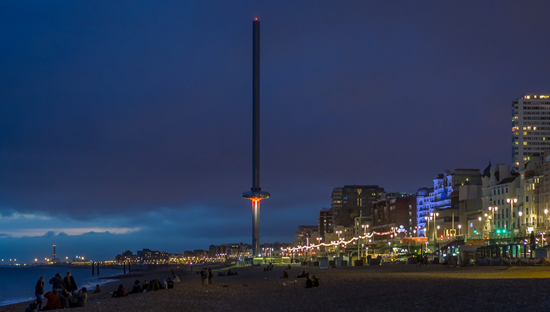
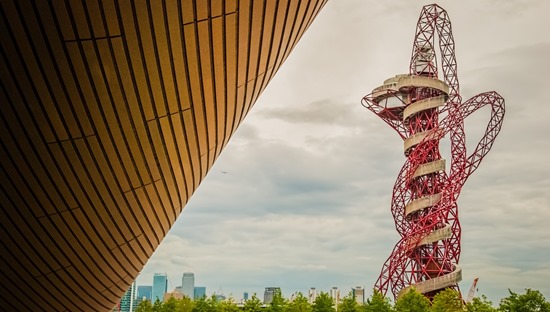







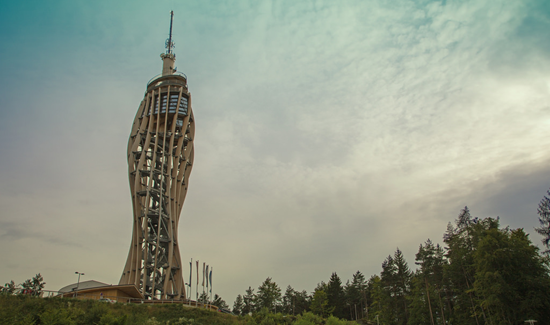






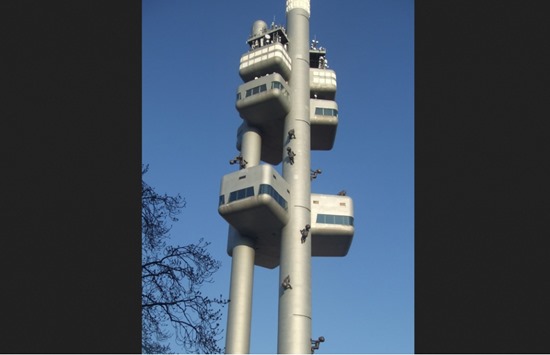
No comments:
Post a Comment
Please adhere to proper blog etiquette when posting your comments. This blog owner will exercise his absolution discretion in allowing or rejecting any comments that are deemed seditious, defamatory, libelous, racist, vulgar, insulting, and other remarks that exhibit similar characteristics. If you insist on using anonymous comments, please write your name or other IDs at the end of your message.